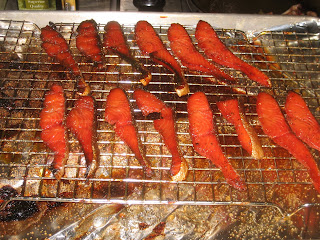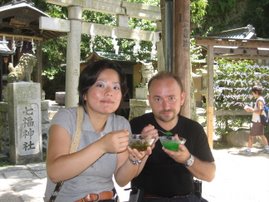

























Three waitresses putting seafood on the grill
as customers order it.
Normally we eat grilled food with just salt on them, or a little bit of soy sauce. No heavy BBQ sauce. We love simple seasonings to get the most out of the taste of seafood. The tsubu kai looks like a turban shell, and you have to pick the meat with toothpick. I know they do not look so appetizing, but who cares about how they look? It tasted a little bit like something between clam and octopus, if you can imagine the taste. Maybe not... But I really liked them. I knew that they were fresh out of ocean, grilled to order, with just a little bit of soy sauce, and they were hot when they came off the grill.


A typical yakitori-ya (-ya means a house) offers a variety of grilled meat and vegetables, and we order them by the skewer as we drink and enjoy casual conversation among friends about work and relationships. The seasoning is usually either just salt or tare, which means a sauce, similar to teriyaki, made with soy sauce, sake, sugar, and some other secret ingredients special to that particular yakitori-ya you are at. At this place we went in Tokyo, everything we ate was seasoned with just right amount of salt. Personally I prefer salt to sauce, because sauce tends to hide the taste of whatever I am having.

The next dish was two each of:
foie gras , quail eggs, tails, and the gizzards.

Next we ate the cartilage from the center of the
breast bone. This is a particular Japanese thing that
I really love grilled with a little salt!
Yes, we eat chicken tails! The tail is nothing but skin and fat. The skin was crunchy, and it was pretty tasty. It is funny to see many Americans trim these fatty parts and throw them away. They trim chicken fat, beef fat, and the fatty part from salmon and swordfish. The fatty part on the fish is usually the belly part, and that’s actually the best part you can have healthwise, but many Americans don’t realize this. They always like to go low fat, then eat an entire pound of whatever they ordered, totally overeating and that’s why there is this epidemic of obesity. Anyway, if you consume everything in moderation, you would not have to worry about the fat content too much. Besides chicken fat is very tasty (think schmaltz). Anyway, I had a great time with my best friend, drinking beer, eating yakitori and talking about life….


Botan ebi, tuna, salmon, scallops, and a local clam called Hokki kai.



In this case, I have a spring form pan lined with parchment paper, bechamel (Italian cream sauce flavored with nutmeg), cooked tortellini, slices of cooked Italian sausage, sauteed mushrooms and shredded cheese.
Line the pan with rolled out dough, ladle in some
bechamel and a layer of tortellini.
Layer with sauteed mushrooms.
Add a layer of sausage.
Cover with more bechamel and a layer of shredded cheese.
Repeat the layers lasagna style, until you reach the top of the pan.
Top with a layer of dough and crimp edges.
Bake at 450 for 1 hr 20 minutes.
Unmold and cool completely on a cake rack.
Slice with an electric knife and enjoy.
This is a very dense pie which is a complete meal in itself. Slice it very thin and serve with a little simple tomato sauce. Chiko's coming home on Monday, so we should be back to Japanese cooking next week!
